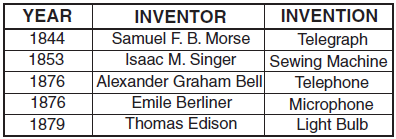Mary Walton and the Noisy Trains
-
Clang, clang, clang! Groaning, Mary Walton buried her head under her pillow. It was no use trying to sleep. The sound of New York City’s Elevated Railway, or “El,” shook the entire apartment.
-
At breakfast Mary watched the milk in her glass quiver. She said to her father, “Papa, I know the El trains are essential. Almost everyone in the city rides them to work. But why do they have to be so noisy?” “I don’t know, Mary,” her father replied. “There’s a challenge for you. Maybe you can find a way to make the trains run quietly.”
-
Mary’s father believed that girls had a right to an education just as boys did. He made sure Mary finished high school even though, in the 1880s, girls often left school at age sixteen to go to work. Knowing she had a good mind that was meant to be used, Mary began to consider the problem at hand. She went to the railway office to see what she could learn. “Has anyone found a way to solve the problem of the noisy El trains yet?” she asked the railway man.
-
“Miss, if you could tell me how to make the El trains quieter, I’d shake your hand,” he answered. He leaned forward. “Let me tell you something. The railway will pay good money to the person who comes up with the answer. I hear some of the top inventors in the country, even Thomas Edison himself, are trying to find a solution.”
-
Mary sighed. If the great Thomas Edison hadn’t been able to find an answer, how could she? Still, Mary knew this invention was important; its benefits would be great. People worked hard. They needed a way to get to work, but they also needed calm, quiet, and good sleep! She began to ride the El trains during every spare minute. She walked underneath the high tracks, looking up to see how they were made.Watching and listening, Mary considered the problem.
-
She still hadn’t found a solution when spring turned to summer, the worst time of year for train noise. Opening the windows helped to cool the hot apartment, but the noise of the train was unbearably loud with the windows open.
-
One night Mary made a little tunnel of pillows and put her head in the middle. “Maybe this will muffle the sound,” she thought. Suddenly she sat up, eyes sparkling, and said, “That’s it! I need a way to muffle the sound!” What material could do that? Rocks were too hard to absorb sound. Wood wasn’t sturdy enough. Mary snapped her fingers. “What about sand? If we put the rails in sand and find a way to keep the sand together, it might work.”
-
Mary spent many nights at the library. Finally she came up with a system to bed the rails in sand that was contained in asphalt. Mary wrote up her plans and sent them to the Patent Office in Washington, D.C. She also sent the railway company a letter describing her invention and how it worked.
-
Weeks passed, and Mary began to think nothing would happen. One day two men appeared at the door. “The president of our railway company wants to thank you for your invention,” they said. “Here’s a check for ten thousand dollars.” Mary could hardly believe it. That was a lot of money! There would be more to come, too, as other railway stations with elevated railways used her invention.
-
One day, Mary went back to the railway office. “It looks like the problem got solved,” she said.
-
The railway man nodded. “By a young woman. Made her rich, I hear.”
-
“Yet there’s still one payment she hasn’t collected,” Mary said, holding out her hand. “You promised to shake my hand!”


